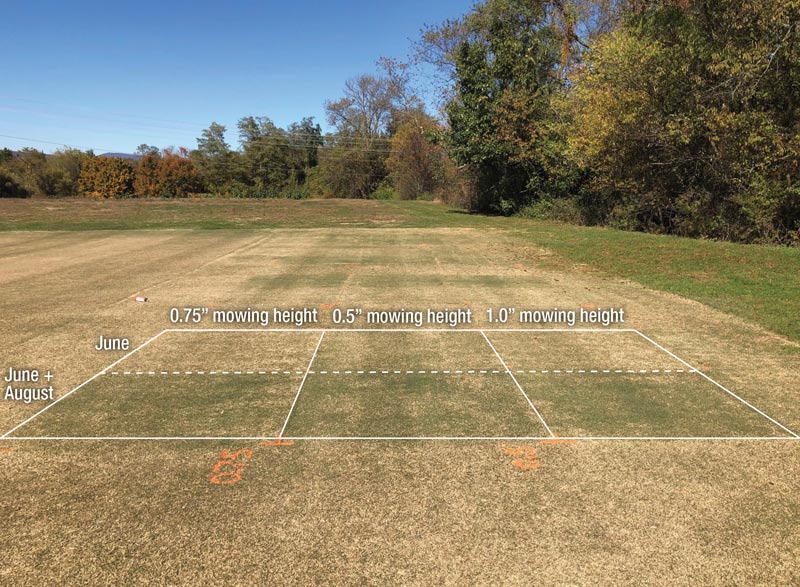
Figure 1. The influence of fall mowing height (vertical strips) and later summer fertility treatments (horizontal strips) on Patriot bermudagrass in Blacksburg, Va. This photo was taken Oct. 24, 2019. Photo by David McCall
Editor’s note: This research is funded in part by the Environmental Institute for Golf.
In the transition zone, hybrid bermudagrasses have become increasingly common as the primary species for golf course fairways, tees, roughs and even putting greens. Throughout the Mid-Atlantic and even farther north, many golf courses have converted fairways and tee boxes from cool-season grasses to hybrid bermudagrasses. However, one of the primary limitations to success is that bermudagrasses are subject to cold-related winter injury.
For instance, harsh freezes during the winter of 2017-2018 resulted in widespread winter injury throughout the southeastern and Mid-Atlantic regions. The damage resulted in high repair and/or renovation costs and decreased revenue for golf course facilities, and created a strain in labor allocation for traditional maintenance operation. Turfgrass managers have cited multiple reasons for observed injury, but the most common involved bermudagrass grown on high-sand-content root zones. These areas are prone to moisture loss, and managers have speculated that cold-induced injury is related to desiccation from inadequate soil moisture.
Additional considerations for winter-injury include cultivation and fertilization. Cultivation practices vary across individual sites, but some managers have noted improved winter tolerance in warm-season grasses with higher fall mowing heights and additional fall fertilization.
Managers often avoid applications after mid-September; however, Gregg Munshaw, Ph.D., from the University of Kentucky and others have shown that low-rate nitrogen applications during fall can promote color retention without negative effects on cold tolerance (1). Although it is widely known that lower-mowed areas experience more winter injury, research is needed to better define the role of fall mowing heights for fairway- and tee-height turf across different nitrogen-fertility levels.
Turfgrass pathogens can also influence the winter survival of hybrid bermudagrasses. Spring dead spot is the most prevalent disease of bermudagrass in regions where cold temperatures induce winter dormancy. The fungi that cause spring dead spot, Ophiosphaerella species, are known to infect the roots of bermudagrass, resulting in increased susceptibility to winter injury.
Bermudagrass protection against spring dead spot requires an integrated approach of cultural and chemical practices, as suppression with fungicides alone has proven inconsistent. To treat large acreages of turf like golf course fairways, tebuconazole has become an industry standard for controlling spring dead spot because of its relative low cost (<$30/acre, personal communication with distributors). Despite widespread adoption of tebuconazole to combat spring dead spot, efficacy is still inconsistent, and strategies to optimize tebuconazole performance are needed.
Joint projects have commenced with researchers at Virginia Tech and the University of Maryland to address winter injury to bermudagrasses in the transition zone. Three primary objectives of this research will address bermudagrass winter survivability.
First, a trial has been initiated to study the impact of soil moisture during freezing conditions on winter injury. As part of this study, fall and winter wetting agent applications will be examined for their impact on winter survival. Our second objective is to quantify how yearly nitrogen fertility and fall mowing height affect winter survivability. A third objective will be to help guide recommendations for managing winter injury associated with spring dead spot by optimizing fungicide performance. We will investigate how wetting agents applied in conjunction with fungicides impact spring dead spot development, with and without post-application irrigation.
All studies were initiated during 2019 at each of three locations: Blacksburg, Va.; Midlothian, Va.; and Salisbury, Md. All trials will take place over two consecutive seasons, and data will be collected throughout 2020 and 2021. The initial imposition of the fertility and mowing height treatments affected the onset of bermudagrass dormancy in fall 2019 (Figure 1, above). As bermudagrass approached dormancy in 2019, plots treated with a second nitrogen application (that is, 4 pounds nitrogen/1,000 square feet/year; 195.3 kilograms/hectare) in August held their green color longer into the fall season than plots only receiving a single nitrogen application (2 pounds nitrogen/1,000 square feet/year; 97.6 kilograms/hectare) in June. Turf quality assessments were inconsistent across all assessments for each site, but were generally higher at mowing heights of 0.75 inch (1.9 centimeters) and 1.0 inch (2.5 centimeters).
To examine the impact of fungicide treatments on spring dead spot, treatments were applied at each location when the five-day average soil temperature dropped below 70 F (21 C) based on Syngenta’s soil temperature estimation website, for consistency. Treatments were reapplied at a four-week interval for the Blacksburg, Va., and Midlothian, Va., locations but at a three-week interval for the Salisbury, Md., location.
When watered-in immediately after application, fall applications of tebuconazole with and without wetting agents did not impact bermudagrass quality as it approached dormancy. However, significant phytotoxicity was associated with wetting agent applications that were not watered-in at the Salisbury, Md., location only. Mild phytotoxicity was observed at the Midlothian, Va., location, but not consistently or at an unacceptable level. No phytotoxicity was observed at the Blacksburg, Va., site.
The final results of this research will be published in GCM.
Acknowledgments
The University of Maryland and Virginia Tech appreciate the support from the Chapter Cooperative Grant Program of GCSAA, the Eastern Shore Association of Golf Course Superintendents, Mid-Atlantic Association of Golf Course Superintendents, Mid-Atlantic Sports Turf Managers Association, Old Dominion GCSA and Virginia GCSA.
Literature cited
- Munshaw, G., E. Ervin, D. Parrish, C. Shang, S. Askew, X. Zhang and R. Lemus. 2007. Influence of late-season iron, nitrogen, and seaweed extract on fall color retention and cold tolerance of four bermudagrass cultivars. Crop Science 47(1):463-463. doi:10.2135/cropsci2007.01.0001er
Joseph Roberts is an assistant professor and Extension specialist in turfgrass pathology and nematology at the Clemson University Pee Dee Research and Education Center, Florence, S.C. David McCall is an assistant professor in the School of Plant and Environmental Sciences at Virginia Tech, Blacksburg, Va. Mark Carroll is an associate professor in the Department of Plant Science and Landscape Architecture at the University of Maryland, College Park, Md.